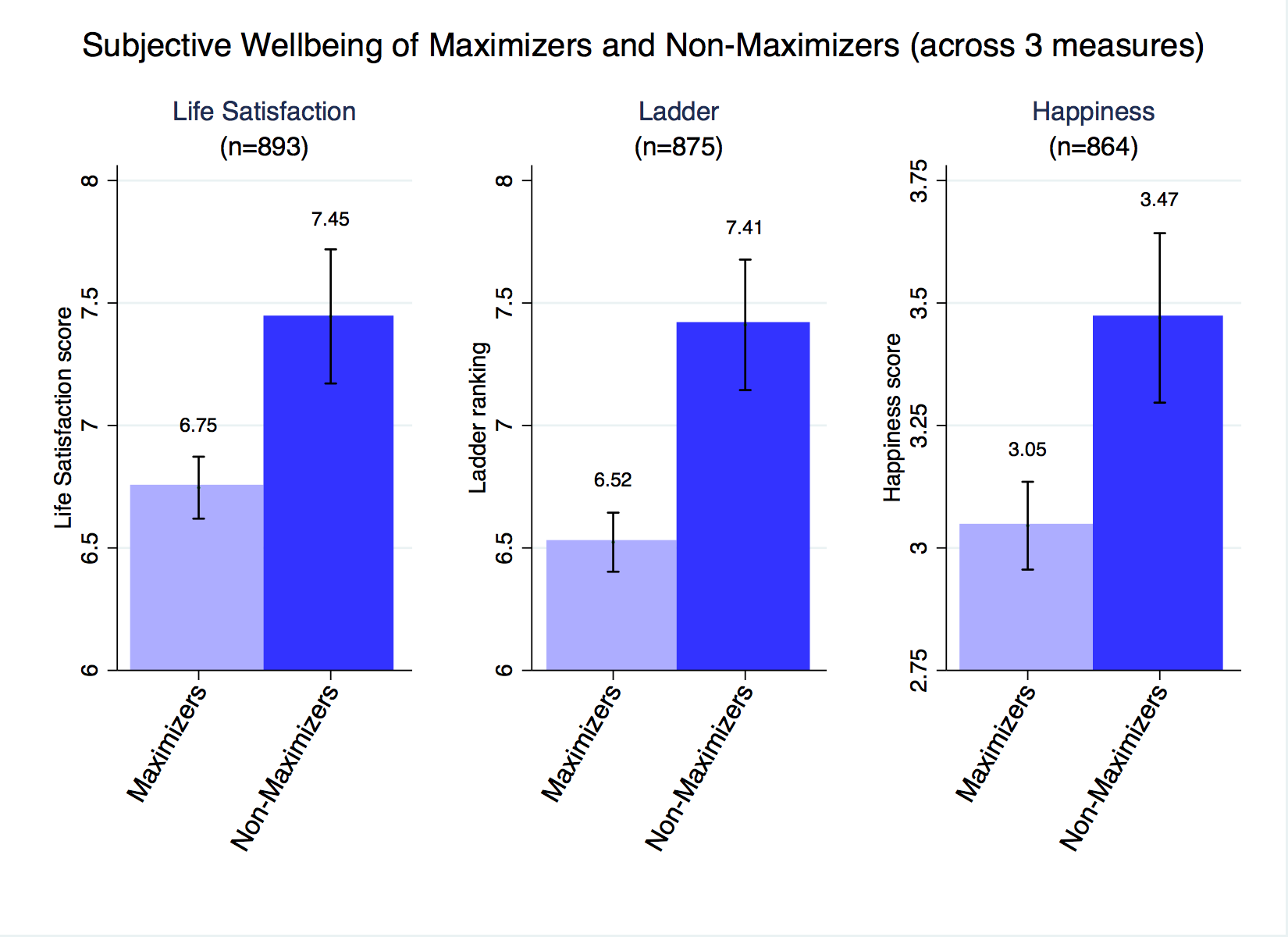
The happiness wave and a core pitfall
There is a growing interest in economics, psychology and in policy circles for subjective well-being (SWB) surveys which elicit people's feelings and sense of satisfaction with their life. The work of authors like Kahneman, Deaton, Layard, Oswald and many others has revealed that subjective well-being (SWB) correlates positively with a variety of things like income, health, marital status, socializing, and negatively with other things like commuting, unemployment or insecurity. Some interesting puzzles have been uncovered about age (the middle-age trough), religion (religious practitioners have greater SWB but religious areas have lower SWB) or child-raising (negative link with SWB).
While policy-makers are more and more interested about incorporating insights from happiness research into their thinking, with the help of OECD guidelines and a regularly published World Happiness Report, one central question remains unclear: What role does SWB, as measured by the usual surveys on emotions or life satisfaction, really play in people's lives? Is SWB the "ultimate goal" and are people doing everything to maximize it, or is high SWB only one goal among many? Despite the undisputed importance of this question for policy-makers and the public, there have been very few empirical tests of what SWB measures actually mean to people and existing studies have been limited to confronting respondents with hypothetical life scenarios or evaluating a single life choice (Benjamin et al. 2012, 2014).
Do people seek to maximize their subjective well-being?
In a new survey, Hannes Schwandt and I provide a direct test for whether SWB measures proxy for utility, based on the entirety of people's actual life choices. We find that most people indeed seek to maximize their SWB. Paradoxically, however, those who do not always maximize their SWB report higher SWB levels.
We asked respondents, after a standard SWB question, if they can think of changes in their lives that would improve their SWB score. The reasoning behind this question is the following. If the SWB score is just one argument among others in the respondents' goals in life, they should easily find ways to improve it, at the expense of other dimensions they care about. Likewise, a consumer can easily increase his expenses on food, but at the cost of reducing expenses on other items. But it is impossible for a consumer to increase his overall satisfaction by changing the full consumption bundle. We therefore think that if a SWB question is such that respondents can hardly find ways to raise their score, it is because they already seek to "maximize" it, meaning that the SWB is a good representation of their goals in life. And these results can be compared across SWB questions, pointing to the ones which are closer to people's goals.
Obviously, such results do not tell us if people really maximize their SWB. They can make mistakes and have imperfect information about what is really good for them. But at least the results give an indication about what people seek to maximize, or believe that they maximize. Moreover, we ask them to tell us what sort of change they can think of, what obstacles prevent them from implementing these changes, and what other values they have in life which conflict with pursuing their SWB.
About 90% do!
Our main results are the following. First of all, about 40% of the respondents can think of possible changes that would raise their SWB. Therefore only slightly more than half of the respondents think that they currently maximize their SWB. However, only about 10% respondents say they actively refrain from implementing these changes because they pursue other goals. In turn this means that close to 90% of the respondents actually seek to maximize their SWB (the remaining 30% who can think of possible changes and actually want to implement them are people whose conditions have recently changed or who are not committed enough to follow through implementing the changes). Interestingly, comparing different SWB measures we find that people are most likely to seek the maximization of life satisfaction, followed by the ladder-of-life question (the ladder of life, used in Gallup surveys, asks people to consider a 0-10 scale as a ladder and tell on which rung they think they stand) and emotions questions.
The fact that the emotion questions come last is well in line with the idea that emotions are an important part of life but not everything, whereas the most general "satisfaction with life" question is the most promising in terms of encouraging respondents to give a global assessment of their situation.
The second main result is that among the other goals that people pursue and for which they are willing to sacrifice some of their SWB, the prominent appear to be about their relatives (mostly their family) and about their future self (especially for young respondents). In other words, one could conjecture that people pursue goals that include the well-being of others and a long-term vision of their personal well-being.
Do you seek to maximize your SWB? Unless you are under severe constraints, it may not be the best strategy, for the others around you, for your future... and for your own SWB!
Our third main result is that SWB is lower among maximizers than among non-maximizer. When comparing advantaged to disadvantaged respondents, in terms of income, education or employment status, we observe that the more advantaged groups tend to have more people who are "non-maximizers" (they could improve their SWB but do not do so because they declare having other goals in life). This is especially true for emotions, and less significant for satisfaction and ladder-of-life. A similar finding is obtained when we divide the sample by SWB level (see the figure). Non-maximizers are found in greater proportions among the respondents with greater SWB, for the three SWB measures.

This result may sound paradoxical. The most successful people, as far as SWB is concerned, contain the greater proportion of respondents who do not maximize SWB. How can one explain this paradox? If everyone started from the same conditions, those who actively seek to maximize their own SWB should have greater SWB.
Are the unhappy constrained or in a self-defeating quest?
One can interpret this result as meaning that inequalities in SWB are not due to some people reaching a greater level of SWB because they care more about their SWB and pursue it more eagerly. On the contrary, inequalities are more a matter of constraints, with the disadvantaged people striving to preserve their SWB and the advantaged people more willing to make some sacrifices on their SWB because they can afford them and still remain at a high level. This interpretation seems very plausible in light of the observation made earlier regarding objective markers of advantage like income, education, employment. The economically and socially advantaged people can afford to think more about other goals, especially in connection with their relatives and their own future.
Another possible interpretation of the phenomenon is that the pursuit of SWB is, beyond a certain point, self-defeating. Sacrificing one's SWB to the service of other people or for long-term goals might actually enhance one's SWB. The high-SWB group is, in this interpretation, made of people who pursued other goals and somehow received the benefits of such endeavors, for instance by having others reciprocating or by having long-term projects come to fruition.
The two interpretations are not incompatible and can reinforce each other. Indeed, the sequence first-investment-then-benefit can unfold over time and involve an element of constraint. Sacrificing one's SWB may be costly in the short run and pay off in the long run. In this perspective, one can conceive that the miserable people, who are disadvantaged in many ways, cannot make this investment and remain stuck in the misery range. On the contrary, better-off people in our sample have perhaps been able, in the past, to afford an investment in others' well-being or in their future self, and they reap the benefits when we interview them.
The bright bottom line and the way ahead
Our results draw a promising picture for policy-makers and proponents of the "happiness wave". The large majority of people seek to maximize subjective wellbeing and even those who don't, might still have someone else's (or their future self's) SWB in mind. And what appears like non-maximizing at the time of the questionnaire might just be a long-run strategy of SWB maximization. Hence, policies that seek to maximize overall SWB are likely to be even in the interest of the few non-maximizers.
The pivotal question whether in general people seek to maximize their SWB, it seems, can be answered with "yes". However, there is another central and perhaps even more important issue that we have been silent about so far. It is the question whether SWB measures are comparable across social groups (or individuals) and within groups over time, and whether they can be used to analyze inequalities and poverty in a useful way. Obviously, comparability is required before SWB enhancing policies can be designed even if, as our results suggest, SWB measures provide a good proxy for what people care about in their lives. Future research exploring this question could provide the next big push to the happiness wave.